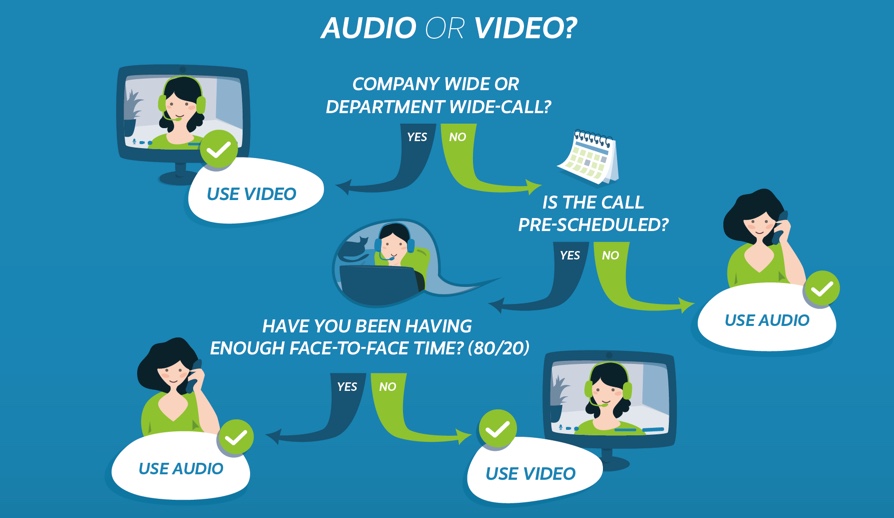
Part II: Your Guide to Synchronous Communication in Remote Work
Meeting with someone instantly feels more personal than sending an email. That is why certain scenarios require synchronous communication over asynchronous communication.
What is synchronous communication?
As mentioned before, synchronous communication is communication that happens in real time. Like a face-to-face meeting, a company meeting on Zoom, or an active chat room. Synchronous communication happens when you send a message and the recipient processes the information and provides an immediate response.
Common examples of synchronous communication include:
- In-person Meetings – In-person meetings are the most direct form of synchronous communication. You’re meeting face-to-face, interacting in real-time, and immediate responses are both expected and given, whether those responses are verbal or non-verbal (body language).
- Video Conferencing / Screen-sharing – When working remotely, online video meetings may be more common than in-person meetings. Video conferencing enables synchronous communication for the same reasons that in-person meetings facilitate synchronous communication.
- Voice Conferencing – Just like in-person meetings or video conferencing, voice conferencing is synchronous because you are having a conversation in real-time with immediate responses, just without the visual element.
- Chat – This can be synchronous or asynchronous depending on company culture, but chat communication is often synchronous because, as the term “instant messaging” implies, people expect and provide instant messages or responses.
Why is synchronous communication important for remote teams?
As mentioned before, the best remote teams implement a balanced combination of synchronous and asynchronous communication.
When used correctly and at the right ratios, synchronous communication offers the following benefits:
Easier Collaboration – Synchronous communication is necessary for work that requires close collaboration. This is because team members can provide immediate feedback, which smooths the collaboration process. Other activities that synchronous communication is well-suited for are brainstorming sessions and coordinating meetings or other events. If you’ve ever experienced the frustration of trying to coordinate a meeting through email, you’ll know what we mean.
Synchronous communication is necessary for work that requires close collaboration. It is also important in situations where important feedback is being provided or situations where the goal is to increase team member closeness.
Increased Camaraderie – Synchronous communication is also better for building relationships. Meeting with someone instantly feels more personal than sending an email. That is why certain scenarios require synchronous communication over asynchronous communication, such as situations where important feedback is being provided or situations where the goal is to increase team member closeness and morale.
Now that we’ve talked about the benefits of synchronous communication, let’s discuss the dangers of requiring too much of it.
If your remote team culture requires members be available and connected the entire work day, you reduce their ability to do good work and increase the possibility of burnout. This is because too much of an emphasis on synchronous communication prioritizes connection over productivity and speed over quality.
Too much synchronous communication has the following consequences:
Lower Productivity Because of Too Many Interruptions – We’ve all experienced this at one point whether it be in an office environment or in a remote work situation. In the office, it’s dealing with that coworker who talks to you every time they pass by your desk for a coffee break, and who takes three coffee breaks every hour. In a remote work situation, it’s being bombarded with chat messages every minute. Either way, the interruptions make it harder to focus on the work at hand and decrease your overall productivity.
Unnecessary Stress Leading to Burnout – Lower productivity leads to the need to work longer hours or work faster. And the need to work for longer to complete work in a speedier manner creates stress, which can lead to burnout.
Lower Quality Discussions and Work – The final downside to an overabundance of synchronous communication is that the pressure to respond quickly results in lower quality discussions because there is no time to refine ideas. And lower quality discussions become lower quality work in the long run.
As you can see, too much synchronous communication results in a negative cascade of cause and effect. That is why we recommend you find the right balance between synchronous and asynchronous communication instead of favoring one over the other.

How to Best Implement Synchronous Communication In a Remote Team
Now that we’ve established what synchronous communication is as well as its benefits and pitfalls. Now it’s time to talk about how to best implement it in your team. The next part of this section consists of best practices to follow when it comes to balancing synchronous and asynchronous communication and using synchronous communication with your remote team.
Have Face-to-Face Time
Including face-to-face time in your remote work communication routine is important for team cohesion and morale. It’s easy to feel disconnected when you’re not going to the office every day, and video calls and company or department-wide retreats will help combat the sense of isolation that team members might feel. Meeting people face-to-face or, better yet, in person forms healthy bonds between team members and helps people put faces to names in the largely digital environment of a remote workplace.
The amount of video calling and retreats that you do will depend on your company culture and capabilities, but having at least one video call every week and organizing a retreat once or twice per year is a good baseline.
It’s also important to have 1-1 calls between team leaders and team members every week. This helps the team feel more personally connected and keeps everyone on the same page in terms of work tasks and progress.
Including face-to-face time in your remote work communication routine is important for team cohesion . Having at least one video call every week and organizing a retreat once or twice per year is a good baseline.
Encourage Chat Best Practices
In a remote work environment, chat makes up the majority of the communication, so it’s important that your team understands chat best practices to reduce noise and confusion and increase productivity.
As mentioned before in the Asynchronous Communication section of this guide, grouping communication by context is essential. This applies whether chat is sync or async for you (as mentioned before, this depends on company culture).
Some chat best practices for grouping communication by context are as follows:
Post in the correct channels or chat rooms to maintain communication traffic. – Too much private, 1-1 messaging can be a sign of cliques, which are roadblocks to productivity. Your team ends up lacking context if most discussions happen privately, and catching people up takes additional time and effort. On the other hand, too much public, large group messaging can be distracting and prevent the completion of deep work. Finding a good balance here is an art and may take some experimentation, but a typical ratio to keep in mind is 30% private conversation and 70% public discussion.
Use tags to notify importance and use them judiciously and maintain context with quotes. – Once you’re in the right channel or chat room, using tags such as @name and quoting other people when you are responding directly to them helps to maintain and strengthen context. This is only necessary in group messaging and not necessary for 1-1 chats.
Consolidate messages for efficient communication. – Another best practice for strengthening context and reducing confusion is putting everything that you want to say on a given topic into a single paragraph of text instead of sending several one-line messages in a row.
Minimize extensive conversations with voice or video calls. – Finally, if something feels too long to communicate over chat, use a voice or video call instead.
Establish Audio and Video Call Guidelines
Although chat will make up the majority of your remote work communication, some things are difficult or too tedious to explain in a text conversation. That is when it’s good to have an audio or video call.
Audio-only or Video and Audio?
A frequent conundrum during remote work is whether or not a call should include video or be audio-only. Here are some good questions to ask to resolve any confusion.
- Is it a company-wide or department-wide call? If yes, using video is good to gain the benefits of face-to-face time such as increased team cohesion and moral.
- Is the call pre-scheduled or impromptu? Generally speaking, you only want to use video for pre-scheduled calls. That way team members do not feel the need to make themselves visually presentable every day when it may not be necessary.
- What is your audio to video call ratio? How many of your calls are audio and how many are video? A good rule of thumb is to have 80% audio calls and 20% video calls for maximum productivity and bonding.

A good rule of thumb is to have 80% audio calls and 20% video calls for maximum productivity and bonding.
Some other audio and video call tips include:
Don’t be afraid to share your screen. – Screen sharing is very helpful when collaborating on projects and discussing ideas. Encourage your team to use this function frequently to add a helpful visual element to your audio-only calls.
Audio is more important than video. – Blurry video is tolerable as long as your audio quality is good (clear, lag-free, and continuous). However, it’s still good to invest in the right technology for improved video quality once your internet connection and audio set-up are good to go.
Use headphones. – The easiest way to get great audio quality is to use headphones with a microphone that’s near your mouth. Wire-connected headphones are best because bluetooth headsets introduce latency, but at minimum you should use something like AirPods. When you use headphones, the audio plays into your ear, so your mic won’t pick up other peoples’ voices. And a microphone near your mouth will pick up your voice so that you get heard as well.
A wire-connected headphone is best because Bluetooth headsets introduce latency, but at minimum you should use something like AirPods.
Use the Right Technology
As we mentioned before, having the right technology infrastructure in place is essential for success as a remote, distributed team. For synchronous communication, you will need a way to conduct audio and video calls, chat, and take and save meeting notes. You may also want to include a task management app so that you can review and assign tasks in an organized way during meetings.
There are a lot of apps out there, but here are our favorites for synchronous communication:
- AirSend – AirSend is an all-in-one app that allows you to send messages, share and organize files, complete tasks, have video or screen sharing calls, and keep notes in a built-in wiki. The messaging, voice and video calling and screen-sharing capabilities fully satisfy your team’s synchronous communication needs. And the built-in wiki and task management functions provide everything you need to take notes and organize tasks during meetings. We use AirSend for almost all of our team’s communication.
- Zoom – Zoom is the golden standard when it comes to audio and video calling. In our experience, it’s best for large conference calls with more people (we use it for our bi-weekly company-wide video conferences). It’s also a good way to conduct team building activities remotely like playing Jackbox games. Because the Zoom client pops up every time you join a meeting and is slower than other options, we don’t like it for impromptu 1-1 meetings as the time wasted waiting for the client to load can be irritating.
- Skype – Unlike Zoom, Skype is great for 1-1 meetings. It’s also nice because you can use it to call phones if you need to, and the chat is permanently connected to your contacts and available. The only negative about Skype is that its audio and video quality can be lacking compared to AirSend and Zoom.
Now that we’ve talked about asynchronous and synchronous communication in remote work, it’s time for some general remote work communication best practices which we will discuss in Part 3 of this guide.